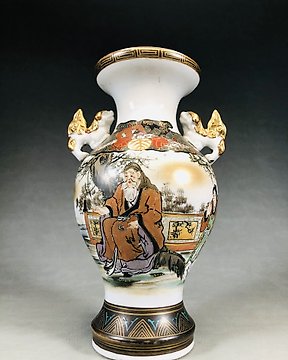
Maljakko - Maljakko, joka kuvaa vanhaa miestä pitelemässä kirjakääröä ja nuorta miestä pitelemässä nosturia - Japani (Ei pohjahintaa)
Nro. 82785401

Nro. 82785401

Kutani-yaki 九谷焼, Kakufuku 角福, A round vase with flowers on both sides
Kutani is one of the pottery-producing regions known for Kutani-yaki, a type of Japanese ceramics. Kutani-yaki is produced in Ishikawa Prefecture, with Kutani City being particularly renowned as a major center for its production.
Kutani ware's "Kakufuku" is a symbol featuring the character for "福" (fuku) written inside a square outline. In China, the characters for "福" and "寿" (ju) are commonly used and frequently appear on ceramics. In Japan, they have been imitated since ancient times, prominently seen in old porcelain production from Hizen (Saga Prefecture), and are also widely used in Kutani ware and Kyoto ware, among others.
In Kutani ware during the Edo period, it was rare for the names of ceramic painters to be inscribed within the raised base; instead, it was common to find the name of the kiln or auspicious symbols like the character "福" (fuku) meaning good fortune.
Kutani-yaki 九谷焼:
Kutani-yaki is said to have been first fired in 1655 in Kutani Village, Echizen County, Kaga Province, during the early Edo period. It was commissioned by Maeda Toshitsugu, the lord of Oyamazaki Castle, to Gotō Saizaburō, a potter in his domain. Kutani-yaki is characterized by its richly colored glazes and bold, vigorous painting, distinguishing it from other overglaze enamel ceramics.
Kutani-yaki is a traditional Japanese ceramic ware produced in the Kutani region of Kanazawa City, Ishikawa Prefecture. This region is particularly renowned and is one of the "Three Great Kilns of Japan," alongside Iga-yaki and Shino-yaki.
Kutani-yaki is known for its beautiful hand-painted designs and distinctive techniques. One prominent feature is the use of vibrant glazes to depict intricate patterns, landscapes, flora, and fauna. Additionally, gold and silver leaf may be applied, adding further elegance to the pottery.
The pottery comes in various shapes and serves different purposes, including tea bowls, vases, plates, teacups, and teapots. These ceramic wares are widely appreciated both within Japan and internationally, often chosen as souvenirs or gifts.
Kutani-yaki boasts a long history, thriving during the Edo period. Even today, traditional methods are preserved, while contemporary artists continue to incorporate new art and design into their creations.
Vase:
Center Diameter 20.5 cm
Top Diameter 10.0 cm
Bottom Diameter 9.8 cm
Height 25.3 cm
Weight 2300 g
Condition:
Although the vase is old, it is in good condition. No chips or cracks. There are some small scratches. It was kept at home. Please see many photos for details.
Atention:
The items listed for sale are all used collectibles. Please consider them to have signs of aging, such as stains, scratches, scuffs, tears, discoloration, fading, fraying, and changes in thread color. We will post as many photos as possible to make it easy to understand. As these are old items, we appreciate your understanding before making a purchase.
Shipping:
The lot will be carefully packaged and shipped from Japan.
We will use either DHL or FedEx for a safe and secure transportation. It usually takes about 2-3 weeks for delivery, and the package will be shipped with a tracking number.
Import duties, taxes, VAT, and any other charges are not included in the item price and shipping cost. Please check your country's import duties before bidding.
031122420327
Näin ostat Catawikistä
1. Löydä jotain erityistä
2. Tee korkein tarjous
3. Maksa turvallisesti